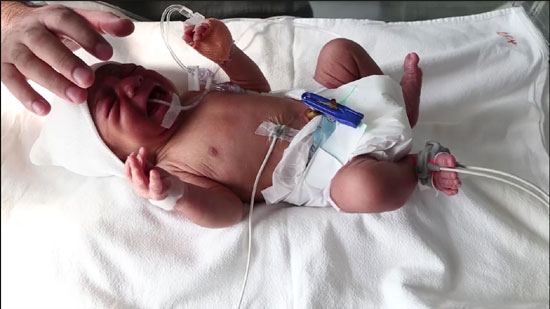|
|
|
Indian Pediatr 2018;55:
432 |
 |
Nose-tapping Test in Hyperekplexia
|
|
Venkat Reddy Kallem*, Sai Kiran and Srinivas Murki
Department of Neonatology, Fernandez Hospital,
Hyderabad, Telangana, India.
Email:
venkat467@gmail.com
|
|
A term, male baby was hospitalized on first day of life in view of
excessive cry, frothing and stiffening followed by apnea during routine
care after birth, and after receiving Hepatitis-B vaccination. Blood
glucose, serum electrolytes, calcium, electroencephalogram and
neurosonogram were normal. Nose-tapping test (Fig. 1 and
Web Video 1) resulted in
exaggerated startle and stiffening episodes without habituation. A
diagnosis of hyperekplexia was considered, and treatment with clonazepam
was started. On titrating the dose of clonazepam, the frequency of
episodes decreased over the next 7 days, and baby was able to breastfeed
from day 4. By discharge, baby was accepting breastfeeds well.
Heterozygous mutations in HSPG2 and TUFM genes located on
chromosomes 1 and 16, respectively, were identified.
 |
|
Fig. 1 Nose-tapping test
|
Hyperekplexia is a rare, hereditary neurological
disorder characterized by episodes of tonic stiffening that is often
confused with epilepsy in the neonatal period. In majority of cases,
hyperekplexia is inherited as an autosomal dominant trait, but autosomal
recessive or X-linked inheritance patterns are also noted. The
genes associated with this condition are GLRA1, SLC6A5,
GLRB, GPHN, and ARHGEF9 (X-linked).
Clinical diagnosis of hyperekplexia is made by a
nose-tapping test. Tapping the nose of a normal baby will elicit either
a blink response or no response and habituation to the response will be
present but in a baby with hyperekplexia, nose-tapping results in
exaggerated startle and stiffening episodes without habituation. Close
clinical differentials include jitteriness, myoclonic seizures, neonatal
tetanus, startle epilepsy, and neonatal abstinence syndrome. The drug of
choice for hyperekplexia is Clonazepam (0.05 to 0.1 mg/kg/day).
Life-threatening events, including severe tonic spasms and apnea, are
best treated by Vigevano maneuver (flexion of infant’s head and neck
toward the trunk). Long term outcome of these infants usually depends
upon the severity of the problem.
|
|
|
 |
|

